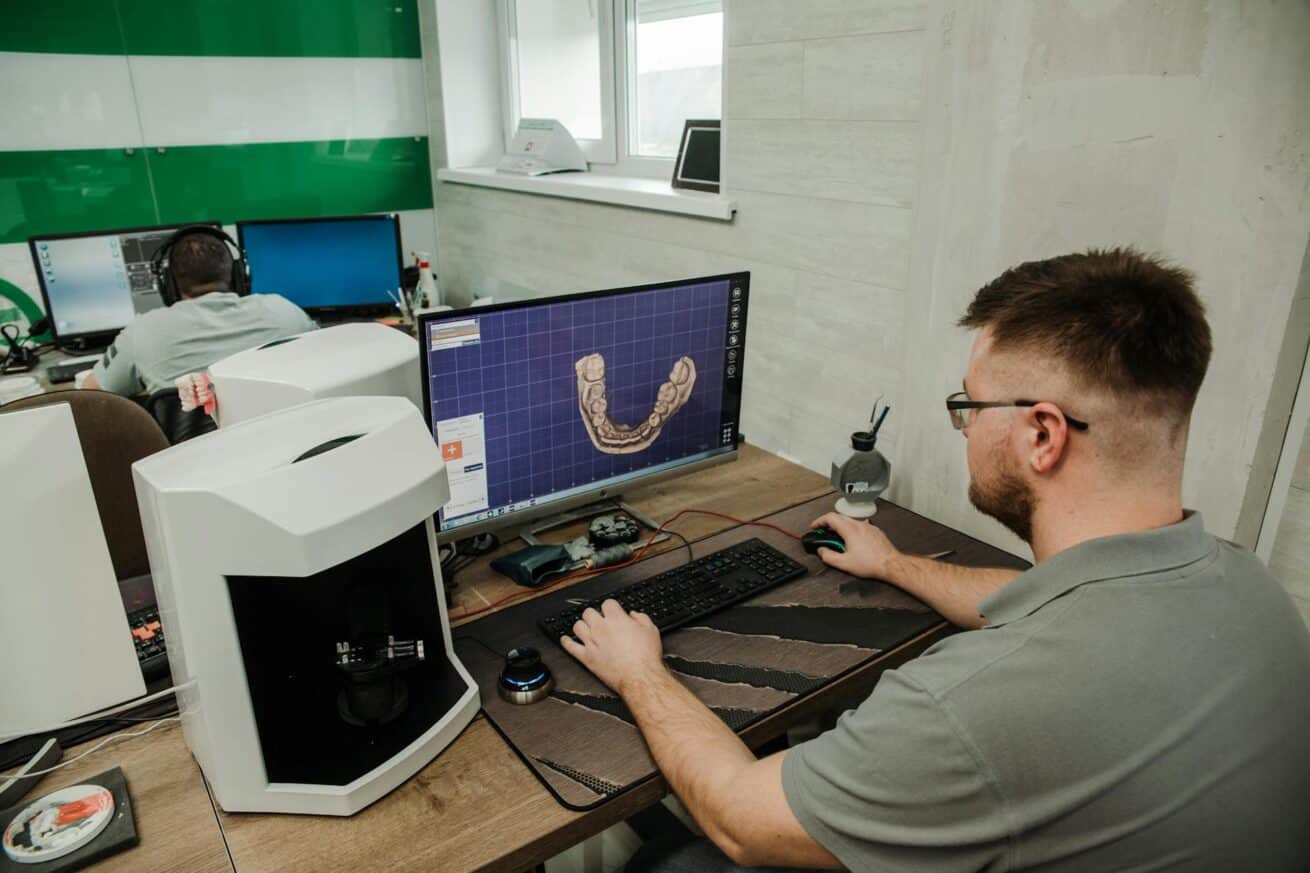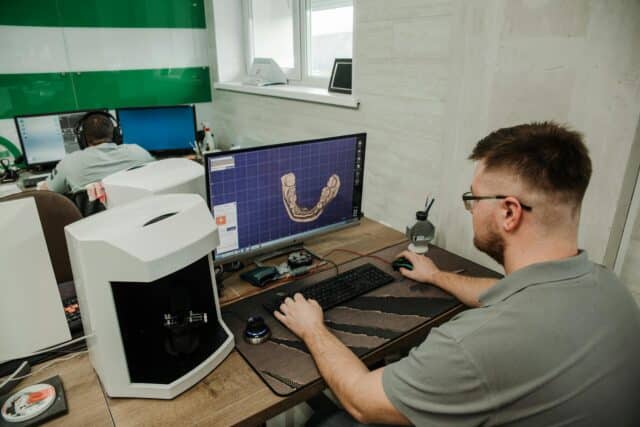Dental implants are a remarkable solution for replacing missing teeth. They can help restore your smile and chewing ability. Two of the most popular materials for dental implants today are titanium and zirconia. Both have unique advantages, making the decision between zirconia vs. titanium implants a significant one.
This comprehensive guide delves into the critical aspects of zirconium implants vs. titanium, exploring their properties and the pivotal factors that might influence your choice. Understanding these materials in depth will help you make an informed decision about restoring your smile and confidence.

History of Implant Materials: A Quick Overview
Dental implants have come a long way from their primitive beginnings. Ancient civilizations used materials like bamboo pegs, seashells, and even animal bones to replace missing teeth. As the understanding of medicine progressed, so did the search for more compatible and durable materials.
By the 18th century, metals came into the picture. Gold and other alloys were initially experimented with due to their strength and durability. However, they lacked one critical element: biocompatibility.
The real breakthrough came in the 1950s, with the discovery of titanium’s remarkable ability to osseointegrate or bond with bone. This property catapulted titanium to the forefront of implant materials. Its biocompatibility, strength, and resilience to corrosion made it the ideal choice for long-term dental solutions.
What Are Titanium Implants?
Titanium is a lustrous transition metal known for its strength-to-density ratio, impressive corrosion resistance, and extraordinary osseointegration capabilities. These physical and biological properties make titanium the go-to material for many surgical implants, including dental ones.
In the context of dental implants, titanium serves as the artificial root. It is shaped like a screw and anchors to the jawbone, creating a solid foundation for the replacement tooth.
Titanium implants have built a reputation for longevity, often lasting for decades with proper care.
What Are Zirconium Implants?
Zirconia, or zirconium oxide, emerged as an alternative to titanium implants. It’s a type of ceramic that boasts exceptional durability and a tooth-like color that appeals to the aesthetic demands of dental patients.
While not as prevalent as titanium, zirconia implants are gaining popularity primarily for their aesthetic properties and hypoallergenic nature. Zirconia is also known for its biocompatibility, resisting plaque buildup, and providing a favorable environment for gum tissue. These traits make zirconia a compelling choice, especially for those with metal sensitivities or cosmetic concerns.
Choosing Between the Two: Zirconia vs. Titanium Implants
Both materials boast unique benefits, addressing different needs and preferences. As such, it’s crucial to understand the distinctions between these two options to make an informed choice that aligns with your health, cosmetic considerations, and lifestyle.
Biocompatibility and Osseointegration
Before delving deeper into the discussion of zirconium implants vs. titanium, it is essential to understand what the terms biocompatibility and osseointegration mean.
Biocompatibility refers to the ability of a material to function alongside living tissue without causing any adverse effects. On the other hand, osseointegration is the process by which a dental implant becomes integrated with the surrounding bone. This essentially makes it part of the body’s skeletal structure and forms a solid foundation for the artificial tooth.
Titanium has long been used in medical and dental fields for its remarkable biocompatibility. It’s a material that the human body readily accepts, and it very rarely causes adverse reactions. Due to this, titanium implants have been the standard in restorative dentistry for decades.
In addition, the osseointegration of titanium implants is well-documented, with numerous studies supporting the material’s effective integration into the jawbone. The resulting strong bond makes titanium implants reliable for restoring function and aesthetics in patients who have lost teeth.
Zirconia also has a reputation for excellent biocompatibility. It’s a ceramic material that’s non-metallic, hypoallergenic, and resistant to corrosion, making it a favorable option for those concerned about having metal in their bodies.
Moreover, zirconia implants have been shown to integrate well with bone tissue. Their osseointegration is comparable to that of titanium implants. However, less long-term research is available because zirconia is a relatively newer material in restorative dentistry.
Durability
This leads us to another crucial point of comparison – how strong are dental implants?
As titanium effectively fuses with bone, the strong bond created helps the implant withstand the forces of biting and chewing over many years. The material itself has excellent mechanical properties, enabling it to resist fracture even in places with high chewing loads.
On the other hand, zirconium implants are made from zirconia, a tough ceramic material known for its toughness and resistance to wear. However, they’re slightly less durable and more brittle than their titanium counterparts, so they may fracture in places of high bite force. As it’s still a new material in the field, it hasn’t been examined extensively for long-term durability.
Nevertheless, zirconium implants still offer more than adequate strength for most patients. It’s also worth noting that zirconia is less likely to conduct heat and cold, a feature that can benefit patients sensitive to extreme temperatures.
Hypersensitivity
While titanium implants are considered safe for most patients, a small percentage of the population has or can develop a hypersensitivity or allergic reaction to metals. Although rare, these reactions can cause symptoms ranging from skin rashes to implant failure. If you have a history of metal allergies, discussing this with your dental professional is essential.
In these instances, zirconia implants may be a more suitable option. The material’s metal-free composition poses minimal risk of allergic reactions, making it a safe choice for hypersensitive individuals.
Ease of Placement
Titanium implants typically come in two pieces: the implant that anchors to the bone and the abutment that attaches the crown to the implant. This two-piece design can provide some flexibility during installation, allowing for minor angle adjustments to optimize the crown’s position.
The ability to make precise adjustments can ensure the dental crown aligns more naturally with the existing teeth. This enhances the overall appearance of the smile line and ensures proper bite alignment, ultimately leading to a natural and aesthetically pleasing outcome.
In contrast, zirconia implants are often designed as a single piece, with the implant and abutment fused together. This can simplify the installation process and reduce the number of steps needed. However, the one-piece design can limit the flexibility in adjusting angles and positioning.
It’s also worth considering that dentists may not be as familiar with placing zirconia implants as they are with their titanium counterparts. This can affect the overall success of the procedure.
Aesthetics
Aesthetics are a significant factor to consider, especially when your front teeth are being replaced.
Zirconia implants stand out for their tooth-like color, which offers a more natural appearance. This is especially beneficial for patients with thin or translucent gums where a metal implant might show through. The ceramic material also does not leave a grayish tinge at the gumline, a significant advantage for many patients seeking a seamless look.
Titanium implants, while not naturally tooth-colored, allow for a range of prosthetic options that match the look of natural teeth and provide excellent results. Dentists can switch out the abutment for a ceramic alternative. Also, in most cases, the color of the metal is not visible once the dental restorations are placed atop the implants.
Cost and Availability
Due to their long standing use and broad adoption by dental professionals, titanium implants are relatively cheaper. Moreover, most dental insurances cover these dental implants, which can significantly defray out-of-pocket expenses.
Another advantage of titanium implants is their availability. Almost every dental surgeon offers this option, and the process for placing titanium implants is well-established and widely practiced.
With that said, zirconia vs. titanium implants can be stark in terms of cost. Zirconia dental implants tend to be more expensive due to their material costs and the newer technology used to manufacture them. Additionally, they may not be as commonly covered by insurance policies, potentially leading to higher expenses.
Ultimately, while zirconia implants have become more common, they’re not as readily available as titanium implants. Fewer dentists may be equipped and trained to place this dental implant, so finding a provider could be more challenging. This factor should definitely be considered when weighing your options.

Let Archpoint Implant Dentistry Help You Discover the Perfect Implant Material for You
The choice between titanium and zirconia dental implants ultimately depends on your needs, preferences, and medical history.
Titanium implants offer proven durability, exceptional biocompatibility, and a long history of success in dental restorations. On the other hand, zirconia implants provide an excellent metal-free alternative with aesthetic advantages and hypoallergenic properties. This makes them suitable for patients with specific cosmetic concerns or metal sensitivities.
Both materials have their unique advantages and potential limitations. As such, it’s essential to study your options carefully and consider how each aligns with your health and aesthetic goals.
At Archpoint Implant Dentistry, we understand the importance of choosing suitable dental implant material to regain a beautiful smile. We’re dedicated to guiding you through the process and providing all the information you need to make an informed choice.
Schedule your appointment today, and let’s discuss your options in detail. Whether it’s titanium or zirconia, we’re here to support you every step of the way toward restoring your overall dental health and confidence.








